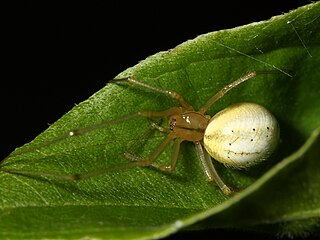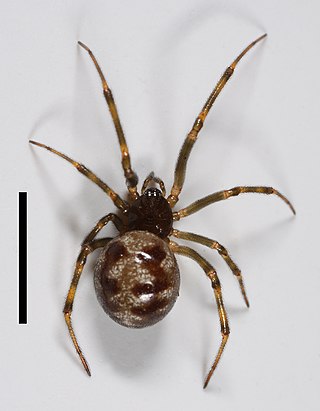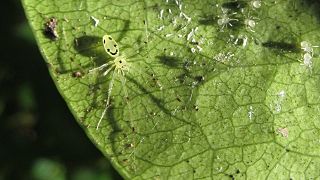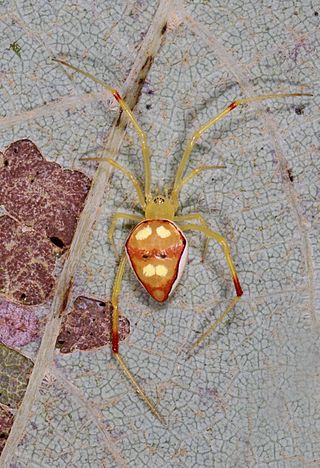
Theridiidae, also known as the tangle-web spiders, cobweb spiders and comb-footed spiders, is a large family of araneomorph spiders first described by Carl Jakob Sundevall in 1833. This diverse, globally distributed family includes over 3,000 species in 124 genera, and is the most common arthropod found in human dwellings throughout the world.

Theridiosoma is a genus of ray spiders that was first described by Octavius Pickard-Cambridge in 1879. They use their web as a high speed slingshot to actively hunt for prey.

The triangulate cobweb spider is a common spider in the genus Steatoda. It is well known for the triangle-shaped pattern on the dorsal side of its abdomen.

Theridion grallator, also known as the Hawaiian happy-face spider, is a spider in the family Theridiidae that resides on the Hawaiian Islands. T. grallator gets its vernacular name of "Hawaiian happy-face spider" from the unique patterns superimposed on its abdomen, specifically those that resemble a human smiling face. T. grallator is particularly notable because of its wide range of polymorphisms that may be studied to allow a better understanding of evolutionary mechanisms. In addition to the variety of color polymorphisms present, T. grallator demonstrates the interesting quality of diet-induced color change, in which its appearance temporarily changes as it metabolizes various food items.

Argyrodes, also called dewdrop spiders, is a genus of comb-footed spiders that was first described by Eugène Louis Simon in 1864. They occur worldwide, and are best known for their kleptoparasitism. They can spin their own webs, but tend to invade and reside in their hosts' webs. This relationship can be commensal or even mutual if the dewdrop spider feeds on small trapped insects that are not eaten by the host. Some species can even prey upon the host.

Styposis is a genus of comb-footed spiders that was first described by Eugène Louis Simon in 1894. It is a senior synonym of Cyatholipulus.

The spider genus Spintharus occurs from the northeastern United States to Brazil. Nicholas Marcellus Hentz circumscribed the genus in 1850, initially as a monospecific genus containing his newly described species S. flavidus.

Thwaitesia is a genus of comb-footed spiders that was first described by Octavius Pickard-Cambridge in 1881.

Anatea is an ant-mimicking genus of South Pacific comb-footed spiders that was first described by Lucien Berland in 1927. As of May 2020 it contains three species, found in Australia and on New Caledonia:
Paratheridula is a monotypic genus of comb-footed spiders containing the single species, Paratheridula perniciosa. The sole species was first described in 1886 under the name Theridion perniciosum. The genus was first described by Herbert Walter Levi in 1957, though it has been described under several different names, including Mysmena 4-maculata, Theridion quadrimaculatum, and Theridion arcadicum,

Theridula is a genus of cobweb spiders, found in many parts of the world. Species vary in size from 1 to 3.5 mm in length.

Rugathodes is a genus of comb-footed spiders that was first described by Allan Frost Archer in 1950. It is closely related to members of Theridion and Wamba.

Spiders are air-breathing arthropods that have eight limbs, chelicerae with fangs generally able to inject venom, and spinnerets that extrude silk. They are the largest order of arachnids and rank seventh in total species diversity among all orders of organisms. Spiders are found worldwide on every continent except for Antarctica, and have become established in nearly every land habitat. As of November 2023, 51,673 spider species in 136 families have been recorded by taxonomists. However, there has been debate among scientists about how families should be classified, with over 20 different classifications proposed since 1900.
Elizabeth Bangs Bryant was an American arachnologist. She worked at the Museum of Comparative Zoology in Cambridge, Massachusetts and was a close acquaintance of James Henry Emerton. She is best known for her studies of the spiders of New England and the Caribbean.

Platnickina is a genus of comb-footed spiders that was first described by A. Ö. Koçak & M. Kemal in 2008.

Phylloneta is a genus of comb-footed spiders formerly considered a sub-genus of Allotheridion, and raised to genus status in 2008. The type species was first described by Eugen von Keyserling in 1884 as Theridion pictipes. As of September 2019 it contains three species and two subspecies with a holarctic distribution: P. impressa, P. pictipes, P. sisyphia, P. s. foliifera, and P. s. torandae.

Pholcomma is a genus of comb-footed spiders that was first described by Tamerlan Thorell in 1869.
Yoroa is a genus of South Pacific comb-footed spiders that was first described by L. Baert in 1984. As of June 2020 it contains two species, found in Australia and Papua New Guinea: Y. clypeoglandularis and Y. taylori.
Selkirkiella is a genus of South American comb-footed spiders that was first described by Lucien Berland in 1924. Originally placed with the Araneidae, it was transferred to the comb-footed spiders in 1972.
Latrodectus revivensis, also known as the desert widow, is a species of venomous spider belonging to the Latrodectus genus and located in the Negev desert and the Arava valley (Arabah).
















